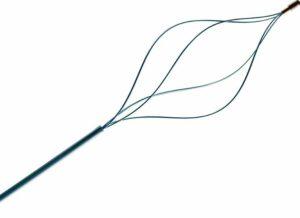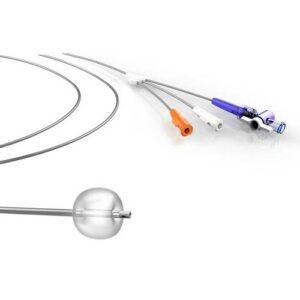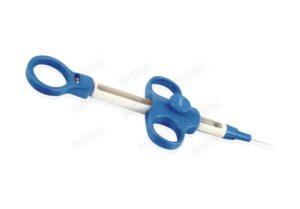In the world of medical procedures, stone extraction baskets play a critical role in the treatment of various urological conditions such as kidney stones. The traditional methods of stone removal have often been time-consuming, challenging, and sometimes even risky for patients. However, thanks to advancements in medical technology, the introduction of stone extraction baskets has revolutionized the field, offering a safer and more efficient approach to stone removal.
This comprehensive handbook is designed to be your blog, equipping you with the knowledge and understanding necessary to harness the full potential of stone extraction baskets. Whether you are a medical professional seeking to enhance your expertise in stone removal techniques or a patient wanting to gain insight into the process this handbook will provide valuable insights, tips and best practices.
Safety is of paramount importance in any medical procedure, and stone extraction is no exception. This handbook will delve into safety measures, precautions, and guidelines to ensure that stone removal is carried out with utmost care and minimal patient discomfort. By understanding the principles of safe stone extraction, you can provide optimal care to your patients while minimizing potential complications.
Get ready to embark on a journey to revolutionize stone extraction and unlock the potential of stone extraction baskets for safe and efficient stone removal. Let’s delve into the world of innovative techniques and transformative technologies that are shaping the future of stone extraction.
Understanding Stone Extraction Baskets
Stone extraction baskets are specialized tools used in the field of urology for the removal of stones from various parts of the urinary tract, particularly the kidneys and ureters. These baskets are designed to safely and efficiently capture and retrieve stones, offering an alternative to more invasive procedures.
The primary purpose of a stone extraction basket is to facilitate the extraction of stones through minimally invasive techniques. They are typically made of flexible and durable materials, such as nitinol, which allows them to navigate the narrow and intricate passages of the urinary system with ease.
Stone extraction baskets offer several advantages over traditional stone removal methods. Firstly they allow for a minimally invasive approach reducing the need for more invasive procedures like open surgery. This results in shorter hospital stays, faster recovery times, and decreased postoperative pain for patients.
By understanding the mechanics and principles behind these baskets, medical professionals can employ them effectively, resulting in improved patient outcomes and enhanced procedural success rates.
Different Types of Stone Extraction Baskets
There are several types of stone extraction baskets available, each designed to address specific stone retrieval needs and anatomical considerations. Here are some common types:
- Helical Basket: This type of basket features a helical-shaped wire structure that allows for easy capture and retrieval of stones. The helical design provides a secure grip on stones of varying sizes and shapes.
- Nitinol Basket: Nitinol, a nickel-titanium alloy, is a commonly used material for stone extraction baskets. Nitinol baskets are flexible, durable, and have shape memory properties, allowing them to return to their original shape even after significant bending or compression.
- Mesh Basket: Mesh baskets are constructed with a fine mesh-like structure, which helps prevent stone fragments from escaping during retrieval. The mesh design facilitates efficient stone capture and retrieval while minimizing the risk of losing small stone fragments.
- Basket with Detachable Tip: Some stone extraction baskets come with a detachable tip, which allows for easy removal of stones from the basket. The detachable tip simplifies the extraction process, particularly when dealing with larger stones or multiple stones.
- Rotatable Basket: Rotatable baskets feature a rotating mechanism at the distal end, enabling the basket to rotate freely while capturing stones. This rotation capability enhances maneuverability and facilitates effective stone retrieval, especially in challenging anatomical locations.
- Zero-tip Basket: Zero-tip baskets have a unique design where the distal end of the basket is flat and has no protruding tip. This design minimizes the risk of mucosal damage during stone retrieval, ensuring a safer procedure.
- Multi-Wire Basket: Multi-wire baskets consist of multiple wires or loops, providing a larger capturing area. These baskets are useful for capturing multiple stones or larger stones that cannot be accommodated by a single-loop basket.
It’s important to note that the availability of specific types of stone extraction baskets may vary depending on the medical facility and the urologist’s preferences.
How to use stone extraction baskets
Using stone extraction baskets requires skill and precision to ensure safe and effective stone removal. Here is a general step-by-step guide on how to use stone extraction baskets:
- Preparation: Before the procedure, gather all the necessary equipment, including the stone extraction basket, cystoscope or ureteroscope, and any other required instruments.
- Patient Positioning: Position the patient appropriately, depending on the procedure and the location of the stone. This may involve placing the patient in a lithotomy position (lying on their back with legs elevated and knees bent) or a modified position as required.
- Anesthesia: Administer local or general anesthesia to ensure patient comfort and pain management during the procedure. Follow the appropriate anesthesia protocols based on the patient’s condition and the urologist’s recommendations.
- Access and Visualization: Insert the cystoscope or ureteroscope into the urinary tract through the appropriate entry point (e.g., urethra or ureter). Use imaging techniques such as fluoroscopy or ultrasound to visualize the stone and guide the basket to its location.
- Basket Insertion: Insert the stone extraction basket through the working channel of the cystoscope or ureteroscope. Ensure that the basket is fully inserted and positioned close to the stone.
- Basket Manipulation: Using the controls on the handle of the basket, manipulate the wires or loops to open the basket and approach the stone. Carefully navigate the basket around the stone, ensuring that it securely encloses the stone without causing any damage to the surrounding tissues.
- Stone Capture: Gently close the basket to capture the stone within its confines. Apply slight pressure to ensure a secure grip on the stone. Take care to avoid excessive force that could potentially dislodge the stone or cause injury.
- Retrieval: Slowly and steadily withdraw the basket, taking caution to maintain control and stability throughout the retrieval process. Monitor the stone’s position and ensure it remains securely captured within the basket.
- Inspection and Repeat if Necessary: Once the stone is successfully retrieved, inspect the urinary tract to ensure no fragments or additional stones remain. If necessary, repeat the stone extraction process with the basket to capture any remaining stones.
- Post-procedure Care: After stone retrieval, remove the cystoscope or ureteroscope carefully, ensuring patient comfort and safety. Provide appropriate post-procedure care instructions to the patient, including pain management, activity restrictions, and any necessary follow-up appointments.
Proper training and familiarity with the specific basket being used are essential to ensure optimal outcomes and patient safety.
Techniques for Stone Extraction Using Stone Extraction Baskets
There are various techniques employed for stone extraction using stone extraction baskets. Here are some commonly used techniques:
- Direct Basket Capture: This technique involves directly capturing the stone within the basket. The basket is carefully guided toward the stone using visual guidance from imaging techniques such as fluoroscopy or ultrasound. Once the basket is in proximity to the stone, it is manipulated to surround and enclose the stone securely. The basket is then closed to capture the stone, and the urologist gently withdraws the basket, removing the stone from the urinary tract.
- Basket Basketing: In certain cases where the stone is difficult to capture directly, a technique known as basket basketing can be employed. This technique involves using one basket to capture another basket containing the stone. The first basket is introduced into the urinary tract and positioned adjacent to the basket containing the stone. The urologist carefully manipulates the first basket to encircle and capture the second basket along with the stone. The combined baskets are then gently withdrawn, extracting the stone from the urinary tract.
- Stone Fragmentation and Basketing: In situations where the stone is too large to be retrieved intact, stone fragmentation techniques may be used in combination with basketing. Once the stone is fragmented, the stone extraction basket is utilized to capture and retrieve the smaller stone fragments. The basket is carefully maneuvered to capture the fragments one by one, and the urologist gently withdraws the basket, removing the fragmented stones from the urinary tract.
- Traction Technique: The traction technique is useful for stones that are embedded or difficult to grasp. In this technique, the basket is inserted adjacent to the stone, and gentle traction is applied to the stone by pulling it towards the basket. The urologist carefully manipulates the basket to enclose the stone while maintaining traction, allowing for successful capture. The basket is then closed, securing the stone within it, and the urologist withdraws the basket, removing the stone from the urinary tract.
The selection of the most suitable technique is crucial for safe and effective stone extraction, minimizing complications and optimizing patient outcomes.
Tips for Stone Extraction Using Stone Extraction Baskets
When performing stone extraction using stone extraction baskets, here are some helpful tips to ensure a successful and safe procedure:
- Careful Patient Evaluation: Thoroughly evaluate the patient’s medical history, imaging studies, and stone characteristics before the procedure. Understanding the size, location, and composition of the stone will guide your approach and choice of stone extraction basket.
- Adequate Visualization: Utilize imaging techniques such as fluoroscopy, ultrasound, or endoscopic visualization to accurately locate and assess the stone’s position and surrounding anatomy. Clear visualization is essential for precise basket manipulation and stone capture.
- Basket Selection: Choose the appropriate stone extraction basket based on the stone’s size, shape, and location. Consider the specific features of different basket types, such as flexibility, shape memory, or mesh design, to optimize stone capture and retrieval.
- Optimal Basket Positioning: Position the basket close to the stone while maintaining a safe distance to prevent tissue damage. Adjust the basket’s position and angle as needed for optimal access and capture.
- Controlled Basket Manipulation: Manipulate the basket with finesse and precision, using gentle and controlled movements. Avoid excessive force that could dislodge the stone or cause trauma to the urinary tract. Patience and steady hand movements are key.
- Proper Basket Opening and Closure: Master the technique of opening and closing the basket effectively. Ensure that the basket opens fully to enclose the stone securely. Verify that the basket’s closure is secure enough to prevent stone escape during retrieval.
- Consider Fragmentation Techniques: If the stone is too large or challenging to retrieve as a whole, consider employing stone fragmentation techniques like laser lithotripsy or pneumatic lithotripsy before attempting stone extraction. Fragment the stone into smaller pieces, making them more manageable for basket capture.
- Gentle Retrieval: During stone retrieval, use gentle and controlled movements to withdraw the basket from the urinary tract. Avoid sudden or forceful actions that could cause stone slippage or damage to the surrounding tissues.
- Assess Complete Stone Clearance: After stone retrieval, assess the urinary tract thoroughly to ensure complete stone clearance. Use imaging or endoscopic visualization to verify that no stone fragments or residual stones remain.
- Post-procedure Care: Provide appropriate post-procedure care instructions to the patient including pain management, fluid intake and follow-up appointments. Monitor the patient for any signs of complications and address them promptly.
Remember, mastering stone extraction using stone extraction baskets requires practice, experience, and continuous professional development. Always prioritize patient safety and follow established protocols and guidelines specific to your medical institution or professional association.
Safety Measures & Maintenance Tips for Stone Extraction Baskets
Safety and maintenance are critical aspects of using stone extraction baskets. Here are some key tips to ensure both safety and proper maintenance:
Safety Tips
- Training and Expertise: Ensure that the healthcare professionals involved in stone extraction procedures using baskets have received proper training and have the necessary expertise. Familiarize yourself with the specific techniques, precautions, and potential complications associated with stone extraction.
- Patient Evaluation: Thoroughly evaluate the patient’s medical history, imaging studies and overall health status before the procedure. Tailor the approach and technique accordingly.
- Sterile Technique: Adhere to strict aseptic techniques during the entire procedure to minimize the risk of infection. Maintain proper hand hygiene, use sterile gloves, draping, and sterile instruments. Follow institutional protocols for disinfection and sterilization of equipment.
- Proper Basket Selection: Select the appropriate stone extraction basket based on the size, shape, and location of the stone. Consider factors such as the basket’s design, flexibility, and compatibility with the chosen approach. Ensure that the basket is suitable for the specific procedure and patient anatomy.
- Optimal Visualization: Utilize imaging techniques such as fluoroscopy, ultrasound, or endoscopy to visualize the stone and surrounding anatomy clearly. This ensures accurate basket positioning, minimizing the risk of unintended tissue damage.
- Controlled Manipulation: Use gentle and controlled manipulation techniques when positioning and maneuvering the basket. Avoid excessive force or aggressive movements that could cause trauma to the urinary tract or dislodge the stone.
- Communication with the Patient: Communicate clearly with the patient throughout the procedure, explaining each step, potential sensations, and expected outcomes. Obtain informed consent and address any concerns or questions the patient may have.
Maintenance Tips
- Regular Inspection: Regularly inspect the stone extraction baskets for any signs of damage, wear, or malfunction. Check the wires, loops, or mesh structure for integrity. Ensure that the basket opens and closes smoothly without any resistance or deformities.
- Proper Cleaning: Clean the basket thoroughly after each use to remove any residual debris or tissue. Follow the manufacturer’s guidelines for cleaning agents, methods, and recommended cleaning equipment. Rinse and dry the basket properly before storage.
- Sterilization: Follow the recommended sterilization methods and guidelines provided by the manufacturer. Use appropriate sterilization techniques such as autoclaving or chemical sterilization to ensure the complete elimination of pathogens.
- Storage: Store the stone extraction baskets in a clean, dry, and designated storage area. Protect them from physical damage, moisture, or exposure to harsh chemicals. Avoid overcrowding or mixing with other instruments to prevent tangling or damage.
- Quality Assurance: Periodically assess the performance and functionality of the stone extraction baskets. This may involve calibration of the basket’s opening and closing mechanism or verifying the functionality of any movable parts. Follow the manufacturer’s recommendations for quality assurance procedures.
- Documentation: Maintain proper documentation of the usage, maintenance, and any observed issues or repairs related to the stone extraction baskets. This helps track their history and allows for timely identification of any recurring problems.
By following these safety and maintenance tips, you can ensure the safe and effective use of stone extraction baskets while maximizing their longevity and performance.
Stone Extraction Baskets From Leading Indian Manufacturers
MEDORAH – STONE RETRIEVAL BASKET
The MEDORAH – STONE RETRIEVAL BASKET is a top-quality stone retrieval basket offered by Medorah Meditek Pvt. Ltd., a renowned manufacturer and global supplier based in India. This innovative device is specifically designed for the safe and efficient removal of foreign objects from the lower and upper digestive system, as well as stones from the biliary ducts. With Medorah’s stone extraction basket, healthcare professionals can confidently address various stone extraction procedures with ease.
The MEDORAH – STONE RETRIEVAL BASKET is available in two designs, both of which are single-use and meet the highest quality standards. The traditional four-wire design and the six-wire design are engineered to effectively remove stones of different sizes from the biliary duct. These baskets offer exceptional maneuverability and control during the stone extraction process, allowing physicians to navigate and retrieve stones with precision.
One of the outstanding features of the MEDORAH – STONE RETRIEVAL BASKET is its rotatable design, which enhances flexibility and accessibility within the ducts. This feature enables medical professionals to navigate through challenging anatomical structures with ease, ensuring accurate stone retrieval and minimizing the risk of complications. Additionally, the atraumatic tip of the basket facilitates smooth insertion into the ducts, streamlining the procedure and reducing patient discomfort.
Stone Extraction Balloon
The Stone Extraction Balloon is a cutting-edge product developed by Medinova Endosys, a leading manufacturer and supplier of stone extraction devices in India. This advanced device is specifically designed for endoscopic biliary stone extraction, providing healthcare professionals with a reliable tool to address challenging stone retrieval cases.
The Stone Extraction Balloon features a triple lumen design that offers wire guide access, facilitating precise stone extraction from the desired location during the procedure. This unique feature allows physicians to navigate the biliary system with accuracy, ensuring efficient stone retrieval and reducing the need for additional interventions. The device is compatible with a 0.035-inch wire guide, enabling seamless integration into existing stone extraction techniques.
Stone Retrieval Basket- Stainless Steel Wire (Tipless)
The Stone Retrieval Basket – Stainless Steel Wire (Tipless) is an exceptional stone extraction basket manufactured and exported by Nidhi Meditech Systems, a trusted name in the medical device industry in India. This innovative device is specifically designed for the effective removal of large stones from the ureter, offering a reliable solution for stone extraction procedures using a semi-rigid endoscope.
The Stone Retrieval Basket features stainless steel wires that work smoothly to grip and retrieve large stones from the ureter. The device’s tipless design ensures optimal performance and durability, allowing healthcare professionals to tackle challenging stone retrieval cases with confidence. With a length of 70 cm, the basket provides sufficient reach and maneuverability during the procedure.
To ensure product integrity and compliance with international standards, the Stone Retrieval Basket is carefully packed in a blister tray with Tyvek paper, adhering to the EN-868-5-series standard. This ensures that the device remains sterile and ready for immediate use, minimizing the risk of contamination during procedures.
In conclusion, the MEDORAH – STONE RETRIEVAL BASKET, Stone Extraction Balloon, and Stone Retrieval Basket – Stainless Steel Wire (Tipless) are highly reliable and efficient medical devices manufactured by reputable Indian manufacturers. With their unique features and advanced designs, these products provide healthcare professionals with the tools they need to perform successful stone extraction procedures. Trust in the quality and performance of these devices for safe and effective stone retrieval in various clinical settings.
Introducing Medzell: Revolutionizing the Medical Device Market
Medzell is a futuristic B2B platform that focuses on promoting Indian medical devices in emerging markets. Through its comprehensive marketplace, Medzell connects healthcare providers with innovative and high-quality products, such as stone extraction baskets. By leveraging Medzell’s platform, healthcare professionals can access cutting-edge tools and technologies to enhance their medical procedures.
Conclusion
In conclusion, Medzell’s high-quality stone extraction baskets offer a reliable and efficient solution for stone removal procedures. With our extensive range of tools, expert tips, and comprehensive insights, you can elevate your stone extraction techniques and achieve optimal outcomes. Explore our platform, embrace the future of medical technology, and experience the transformative power of Medzell’s stone extraction baskets. Shop now and revolutionize your stone removal procedures for enhanced patient care and improved efficiency.





